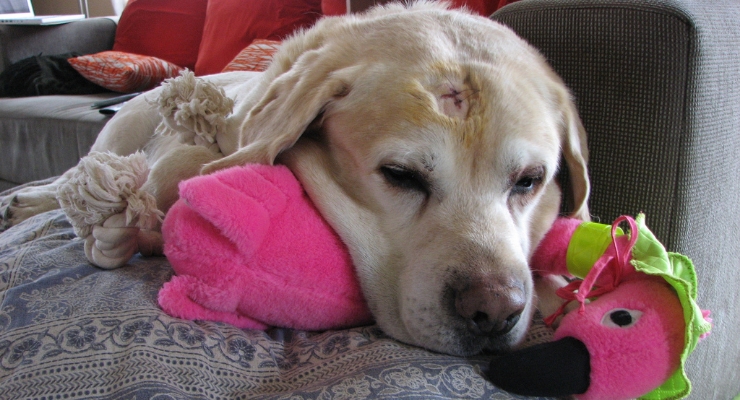
Most of us are familiar with the term “wart” — or think we are — and we may even have 1 or 2 ourselves. What you are about to read may surprise you.
Generally speaking, warts are small lumps that grow on the skin’s surface. But what you may not know is that the term “wart” is more properly reserved for a type of harmless lump caused by a virus — the papillomavirus.
Thus, warts are more accurately called papillomas or papillomatous growths. I don’t know about you, but I find “wart” easier to say and spell, so let’s stick with that.
Warts are harmless lumps that pose no danger to the animal. They do not spread to other parts of the body and are of little importance other than altering the cosmetic appearance of the skin.
Bizarrely (considering the viral link to warts), some breeds such as Cocker Spaniels and Kerry Blue Terriers are more likely to develop warts, as are males more likely than females. Go figure!
Warts are common enough that you’ll see all sorts of comments from people online such as: “My dog has warts on his back,” “My dog has warts all over his body,” “My dog has warts in her mouth,” “…on his chin,” “…on her face,” and so on…
Symptoms
Warts are small (less than 1 centimeter) raised areas on the skin. If you have a good feel around the wart, you find it is entirely located above the skin with no thickening or root beneath the skin. They may have a fissured or cracked appearance; some are the same color as the skin while others may be a contrasting gray or pink.
Young dogs sometimes grow impressive crops of white-colored warts in their mouth or lips. They are the most peculiar things to see, a bit like tiny, chalky mushrooms growing on the tongue. Yes, warts on a dog’s tongue.
This, again, is just a viral infection, and it is rare for the pet to need treatment because the warts disappear of their own accord after a few weeks or months.
Warts are just a fleshy outgrowth; they are never inflamed or sore. The surface should always be dry, just like the skin itself.
If your pet has a skin lump that is inflamed or sore, then get it checked by a vet because it may not be a wart, and it may need to be investigated and removed.
Most animals are unaware they have warts because they are neither painful nor uncomfortable — nor do they make the pet ill. The only way a wart causes a problem is if it is caught and bleeds during grooming or it sits under the collar and gets chafed.
Causes
Young, inquisitive dogs are at greatest risk of encountering the papillomavirus.
When they sniff and explore, they may get infections on their face or tongue. It is unusual for these to cause a problem, although in rare cases a dog grows so many at once around the lips or on the tongue that it becomes difficult to eat.
Older dogs, however, develop warts for no reason. It does not seem the papillomavirus is involved in these animals, and it appears it is more just an old-age change.
Diagnosis
This can often be made just by looking and feeling the lump as well as from the dog’s history. A non-inflamed superficial skin lump that is slow to grow and not causing any discomfort has a good chance of being a wart or papilloma.
If there is any variation from this, such as the lump is growing quickly, inflamed or associated with skin thickening, then removing the mass to send it for histology is the safest course of action.
If there is any suspicion that the lump is anything other than a wart, then removal or histology may be necessary to check that the mass is nothing more serious such as a mast cell tumor.
Was YOUR Pet Food Recalled?
Check Now: Blue Buffalo • Science Diet • Purina • Wellness • 4health • Canine Carry Outs • Friskies • Taste of the Wild • See 200+ more brands…

Treatment
It is entirely appropriate to leave a suspected wart alone rather than put the pet through an operation as it may go away on its own after a few months.
The exception would be a wart that grows in a place where it causes a problem. This includes anywhere where a collar or harness rubs it or on the edge of an eyelid. A wart that grows where it rubs the surface of the eye could cause the cornea to become ulcerated, and the wart needs to be removed to avoid superficial trauma to the eye.
In the rare event that a dog grows so many papillomas in his mouth that they cause a problem, cryosurgery (freezing the lumps) is an effective, noninvasive procedure.
Prevention
In theory, avoiding contact with the papillomavirus will stop young animals from getting warts. However, by their very nature viruses are microscopic, and it is not possible to know if a surface is contaminated or not.
References
- Veterinary Dermatopathology. Gross, Irkhe & Walder. Publisher: Mosby Year Book.
- Small Animal Dermatology. Scott, Miller & Griffin. Publisher: Saunders.
This pet health content was written by a veterinarian, Dr. Pippa Elliott, BVMS, MRCVS. It was last reviewed Dec. 17, 2018.



